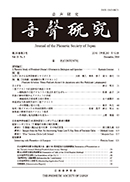Volume 26, Issue 1
Displaying 1-7 of 7 articles from this issue
- |<
- <
- 1
- >
- >|
Research Articles
-
2022Volume 26Issue 1 Pages 1-12
Published: October 31, 2022
Released on J-STAGE: October 31, 2022
Download PDF (693K) -
2022Volume 26Issue 1 Pages 13-26
Published: October 31, 2022
Released on J-STAGE: October 31, 2022
Download PDF (686K) -
2022Volume 26Issue 1 Pages 27-42
Published: October 31, 2022
Released on J-STAGE: October 31, 2022
Download PDF (1305K) -
2022Volume 26Issue 1 Pages 43-52
Published: October 31, 2022
Released on J-STAGE: October 31, 2022
Download PDF (347K)
Summaries of Presentations at the 344th Regular Meeting
-
2022Volume 26Issue 1 Pages 53-54
Published: October 31, 2022
Released on J-STAGE: October 31, 2022
Download PDF (273K)
Information for Contributors
-
2022Volume 26Issue 1 Pages 55-61
Published: October 31, 2022
Released on J-STAGE: October 31, 2022
Download PDF (428K)
Information
-
2022Volume 26Issue 1 Pages 62
Published: October 31, 2022
Released on J-STAGE: October 31, 2022
Download PDF (212K)
- |<
- <
- 1
- >
- >|
